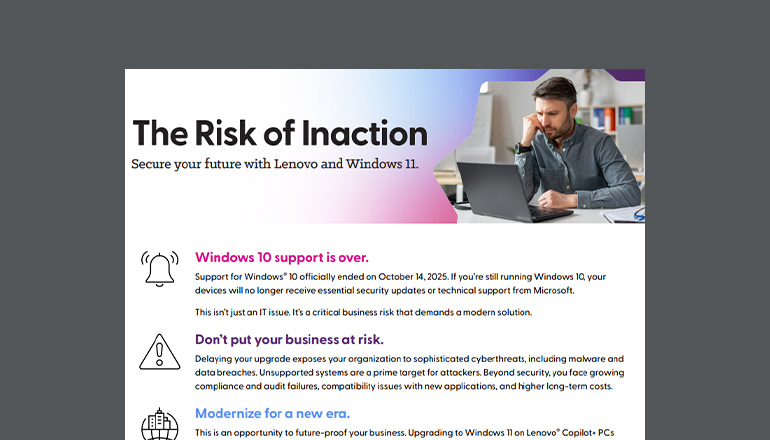Infographic text included for screen readers:
10 Questions To Ask When Evaluating IT Service Providers
Question 1
What’s your motivation for finding a service provider?
Whether you want to get more agile, increase scalability for an upcoming project or just provide extra support for your overworked IT department, there are plenty of good reasons to bring in a partner for IT services. If you’re currently looking for a provider, start by considering your needs, including drivers for innovation, growth and cost reduction.
Top reasons why businesses outsource IT:
- 49% — Freeing employees to focus on core business objectives
- 46% — Access to skills not available in-house
- 45% — Cost reduction
- 39% — Greater flexibility in the use of resources
- 15% — Improved ability to innovate
Question 2
Which workloads will you be outsourcing?
Once you know your motivation, you’re ready to get specific. Consider what you want your IT partnership to look like. Do you want your IT provider to handle all your IT tasks or just a small piece of the daily workload? Are you looking for a long-term relationship or is your need only temporary?
Ideas on what to outsource:
- End-user support (service desk and on-site)
- Device provisioning and maintenance
- Migrations and deployments
- Unified endpoint management
- Security and governance
Question 3
How does your current solution stack up?
Before you bring in a service provider, take stock of your current state and establish a benchmark to measure future performance against. By measuring your company’s current performance against industry standards, you’ll be able to identify opportunities for improvement.
Common benchmarks to note:
- Cost per ticket
- Tickets per user per month
- Tickets per technician per month
- Mean Time to Resolution (MTTR)
- First-Call Resolution (FCR) percentage
Question 4
Have you identified and quantified your goals?
If your service provider has a clear understanding of your objectives, they’ll be better able to deliver results for your business. Try to set goals that are well-defined and specific — doing so will make it easier for you and your service provider to work together. If you can’t clearly state your objectives, consider adjusting the scope of the project.
Well-defined goals will help you:
- Prevent miscommunications.
- Obtain unambiguous proposals.
- Avoid hidden costs.
- Set realistic timelines.
Question 5
Has your service provider been fully vetted?
Your Managed Service Provider (MSP) will become an extension of your team — and a reflection of your organization. Be sure you understand your service provider’s capabilities and limitations.
Things to consider when evaluating an MSP:
- Do your organizations share similar values?
- Is the pricing structure transparent?
- Does the MSP have strong industry recognition, skills and experience?
- Can the MSP meet the same security and compliance standards as the in-house team?
- Will the MSP provide dedicated account managers and resources?
Question 6
Do you have a detailed roadmap?
When you engage with potential providers, make sure they’re prepared to provide you with a roadmap for project rollouts and service implementation. This resource is essential to help you monitor progress and evaluate how your service provider is performing against goals and milestones.
Question 7
Does the execution methodology make sense?
Look for holes in the plan. Bringing internal stakeholders into the conversation early in the process can help you avoid unanticipated roadblocks and expenses. Plan for risks now so you’ll be prepared to mitigate them later.
Issues you may encounter:
- Communication difficulties
- Low user adoption rate
- Unexpected or hidden costs
- Disruptions to business continuity
- Data security and privacy vulnerabilities
- Lower quality of service than expected
Question 8
Are your Service-Level Agreement (SLA) metrics realistic?
It’s important for you and your provider to understand the SLAs you want to meet in the given timeframe. Your benchmarking exercise can help you set strong, achievable SLAs. These will also help MSPs better understand and meet your expectations.
Pro tips on SLAs
- Set SLAs that will close performance gaps based on benchmarks.
- Consider pairing SLAs with satisfaction survey results.
- Ensure the SLAs align to your business goals.
- Be prepared to change SLAs as business needs evolve.
Question 9
Have you seen a proof of concept?
Minimize risks by asking for a proof of concept. This will give you a chance to identify and solve issues that weren’t obvious in the initial proposal.
Proof of concept benefits:
- Gather data to support your business case.
- Refine the implementation plan if needed.
- Address communication or support gaps earlier.
- Reduce risks to the business.
Question 10
Have you established a clear system of communication?
The success or failure of a project can often be linked back to the quality of communication. Establishing lines of communication early and clearly specifying roles and responsibilities should help you ensure better outcomes. However you decide to proceed, make sure your expectations are always clearly communicated.
Communication is key.
- Put a process in place for escalating issues.
- Implement collaboration apps as needed.
- Provide training for internal and external teams.
- Communicate regulatory and security standards.
- Meet regularly to track progress toward goals.
- Invest in managed adoption processes.
Source:
Raconteur. (2018, May 3). Future of Outsourcing.








